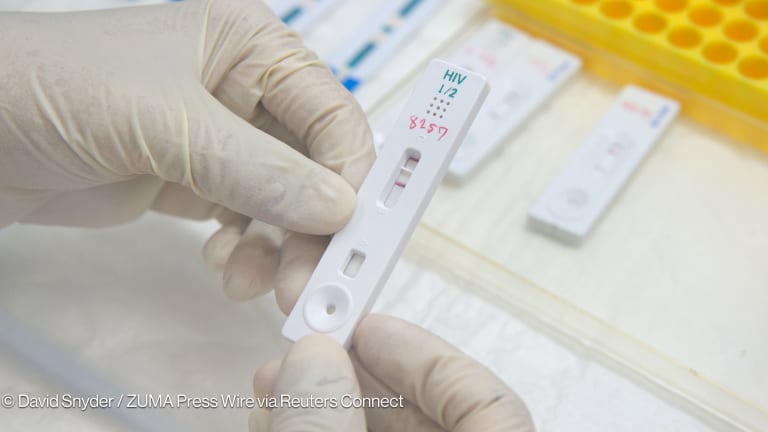
Harm reduction interventions — such as needle and syringe programs and opioid agonist therapy — operate in an extremely fragile environment.
There are an estimated 15.6 million people who inject drugs worldwide. Yet more than half of all countries have not implemented any needle and syringe programs, dozens of nations around the world provide no opioid agonist therapy for drug dependence, and there is still significant political opposition to the concept of harm reduction itself — of meeting people where they are, without judgment.
People who use drugs may face additional risks in the context of COVID-19 on the basis of preexisting health conditions and, in some cases, weakened immune systems. Where drug use occurs in crowded areas or people are street-based and have limited ability to stay at home or access facilities for good hygiene, risks increase again.
Despite the incredible efforts of the global harm-reduction community to adapt to rapidly changing circumstances and maintain health services for people who use drugs, COVID-19 represents a significant impediment to harm reduction outreach, linkages to broader health systems, and the way harm reduction services are funded.
Funding for harm reduction services was already in crisis before COVID-19 hit. A 2018 report by Harm Reduction International revealed an 87% shortfall in funding for key harm-reduction services and advocacy in low- and middle-income countries and an alarming decline in international donor funding over the past decade. The Global Fund to Fight AIDS, Tuberculosis and Malaria remains the largest funder of harm reduction services in low- and middle-income countries.
While the coronavirus-obscured future leaves many questions unanswered, there are three key actions we can take to protect the harm reduction sector in the coming months:
1. Advocating for the continuity of services
First and foremost, donors must continue to fund existing harm-reduction programming. Funds must also be provided so services can adapt to lockdowns and physical-distancing measures. This includes ensuring that harm reduction service providers, outreach workers, and clients have access to adequate personal protective equipment.
We know that disruptions to services can have a catastrophic impact on HIV and hepatitis incidence among people who use drugs. In Belarus, when a harm reduction program experienced an eight-month funding gap, syringe distribution reduced by a staggering 75%. If this gap in services had been avoided, modeling suggests the program would have averted 53% more HIV infections over eight months. It would have also cost less to avert each infection.
Similarly, in Mexico, a study confirmed that the significant donor withdrawal in 2013 dramatically reduced access to harm reduction services, with fewer outreach workers and lower-quality harm-reduction packs.
Civil society, communities, and experts must insist donors and governments do not draw upon funds previously committed to harm reduction to respond to COVID-19. Funding for harm reduction must be sustained throughout the pandemic to prevent rapid increases in HIV and viral hepatitis.
Too frequently, harm reduction services have been interrupted, deprioritized, or underfunded, with significant implications for both individuals and health systems, including an increase in HIV infections and additional costs for treatment.
2. Making the investment case for harm reduction
In the current reality, where governments and donors are making incredibly difficult decisions about the allocation of resources every day, it is imperative that we use the evidence available to safeguard harm reduction funding.
Harm reduction interventions are both cost-effective and cost-saving in the longer term. A study from Yunnan in southwestern China found that $1.04 million spent on needle and syringe programs from 2002 to 2008 is estimated to have saved $1.38 million to $1.97 million in HIV treatment and care costs due to the number of infections prevented.
Similarly, evidence from Slovakia demonstrates that every euro invested in harm reduction generated benefits worth €3 ($3.20), and every hepatitis C infection averted would save €106,000 in treatment and quality-of-life costs over 25 years.
By preventing HIV and viral hepatitis, harm reduction services shield the health system from future costs relating to treatment and emergency health care. In the current economic climate, strategic health investments ensuring value for money and cost-effectiveness are more crucial than ever.
3. Strengthening community leadership and accountability
Finally, while the cost-effectiveness evidence makes harm reduction a viable contender for inclusion in budgets, cost-effectiveness only delivers results when the quality of services is retained. In short, “cost-effective” does not mean “the cheapest option.”
Key to quality services is the meaningful participation of people with lived experience of drug use. In practical terms, this means the community must be involved — from the start — in designing, planning, and decision-making about services and funding. This includes decisions made by local or national governmental bodies or recipients of international donor funding — for example, the principal recipients or country coordinating mechanisms under The Global Fund.
Meaningful participation further paves the way for accountability in service delivery and funding decisions. Accountability requires funders and governments to make their allocations, expenditures, and underspending and reprogramming of funding publicly available.
When the harm reduction sector and the community of people who use drugs achieves these measures of transparency and accountability, we shift power dynamics and disrupt structures that have traditionally excluded marginalized communities and perpetuated inequality. Not only do these steps improve care for the most marginalized communities, but they promote economic models that prioritize heath, well-being, and human rights over never-ending growth.
Harm reduction and the rights of people who use drugs need to be prioritized if we are to build a more compassionate and just world for all.








